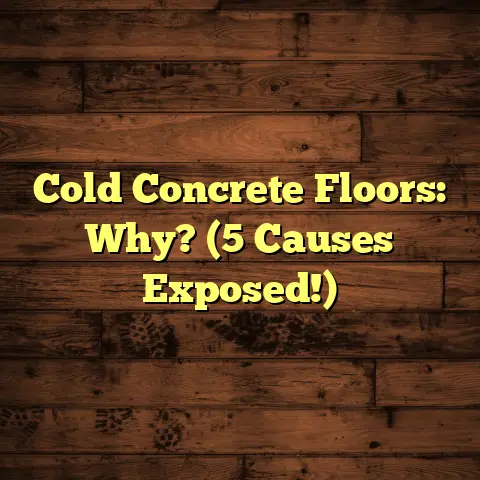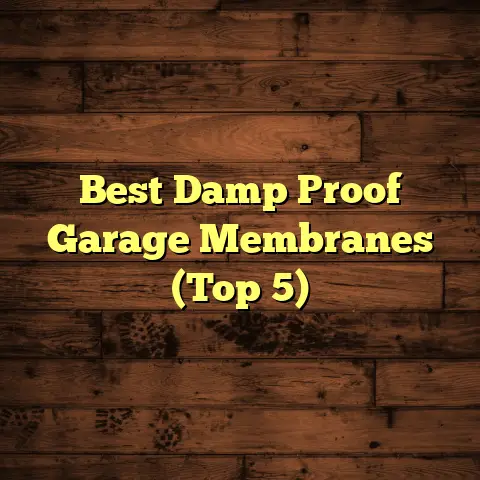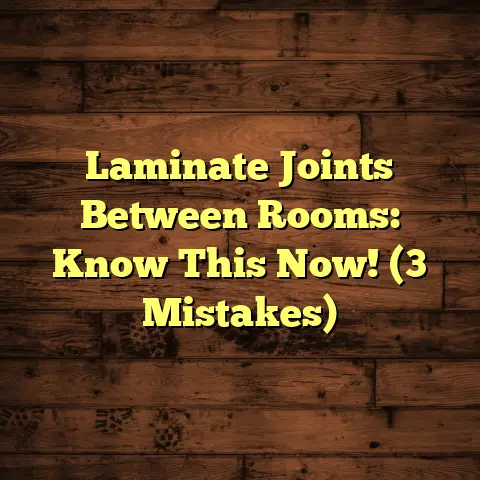Maintaining Your Garage Floor: Pro Tips (3 Secrets)
Most of us don’t. Garages are usually the forgotten stepchild of the house, right?
But think about it – your garage floor takes a beating. Cars, tools, spilled oil, the occasional rogue hockey puck…
It’s a battlefield down there!
As a flooring contractor with over 15 years of experience, I’ve seen it all.
And let me tell you, a well-maintained garage floor isn’t just about looks.
It’s about safety, functionality, and even increasing the value of your home.
A clean, durable floor can transform your garage from a storage dumping ground into a workshop, a gym,
or even a cool hangout spot. Trust me, I’ve seen it happen.
So, are you ready to unlock the potential of your garage floor? Let’s dive into the secrets.
Section 1: Understanding Garage Floor Materials
Okay, let’s talk materials. Not all garage floors are created equal. You’ve got a few main contenders:
-
Concrete: The classic. Usually the base layer in most garages. It’s tough, but porous. Think of it like a sponge – it soaks up everything. And when it soaks up oil and chemicals, it can stain and degrade over time.
-
Epoxy Coatings: This is where things get interesting. Epoxy is a resin that’s applied over concrete. It creates a hard, durable, and chemical-resistant surface. I’ve used epoxy on countless garage floors, and it’s a game-changer. It looks great, it’s easy to clean, and it protects the concrete underneath.
-
Rubber Mats: These are great for specific areas, like under a workbench or where you park your car. They provide cushioning and protect the floor from scratches and impacts. I often recommend them for people who do a lot of DIY projects.
-
Tiles (PVC or Interlocking): These are becoming more popular. They’re durable, easy to install (usually snap-together), and come in a variety of colors and styles. They’re also relatively easy to replace if one gets damaged.
So, why does material selection matter so much?
Well, imagine you’re trying to clean up an oil spill. If you have bare concrete, that oil is going to soak right in, leaving a permanent stain.
But if you have an epoxy coating, you can just wipe it up with a rag. Big difference, right?
The right material can save you time, money, and a whole lot of headaches in the long run.
Secret #1: Know Your Enemy (and Your Floor)
Here’s the first secret: understand how different materials react to spills, stains, and impacts.
For example, did you know that salt can actually damage concrete over time?
That’s why it’s so important to clean up road salt that gets tracked into your garage during the winter.
I’ve seen concrete floors crumble and crack because of salt damage. It’s not pretty.
According to a study by the Portland Cement Association, de-icing salts can accelerate the deterioration of concrete,
especially in freeze-thaw conditions. (Source: Portland Cement Association)
Think about it like this: you wouldn’t use the same cleaning product on a delicate silk shirt as you would on a pair of work boots, would you?
The same principle applies to your garage floor.
Knowing the properties of your flooring material will help you choose the right cleaning products and maintenance techniques to prevent long-term damage.
For instance, if you have an epoxy floor, avoid using abrasive cleaners that can scratch the surface.
Instead, opt for a mild detergent and a soft mop.
If you have rubber mats, be careful about using harsh chemicals that can degrade the rubber.
A simple soap and water solution is usually sufficient.
Section 2: Regular Maintenance Practices
Alright, now that you know what your floor is made of, let’s talk about keeping it clean.
Think of it like brushing your teeth. You wouldn’t skip brushing for a week, would you?
The same goes for your garage floor. Regular cleaning is essential for preventing stains, damage, and that general “grungy” look.
Daily and Weekly Cleaning Routines
-
Sweep Regularly: This is the easiest and most effective way to keep your garage floor clean. Sweep up dirt, dust, leaves, and other debris at least once a week. I recommend using a stiff-bristled broom for concrete floors and a softer broom for epoxy or tile floors.
-
Address Spills Immediately: This is crucial. The longer a spill sits, the more likely it is to stain or damage the floor. Keep some shop towels or absorbent cloths on hand for quick cleanups.
-
Mop as Needed: For epoxy or tile floors, mopping is a great way to remove dirt and grime. Use a mild detergent and warm water. Avoid using too much water, as this can seep into cracks and cause problems.
Deep Cleaning Techniques
Sometimes, sweeping and mopping just aren’t enough. That’s when you need to break out the big guns.
-
Pressure Washing: This is a great way to deep clean concrete floors. Be careful not to use too much pressure, as this can damage the concrete. Also, make sure to wear safety glasses and gloves.
-
Floor Scrubbing Machines: These are ideal for large garages or for floors that are heavily soiled. They can be rented from most home improvement stores.
-
Eco-Friendly Cleaning Solutions: I’m a big fan of using eco-friendly cleaning solutions whenever possible. There are plenty of effective and environmentally safe options available.
For example, you can make a simple degreaser by mixing equal parts white vinegar and water.
This works great for removing oil and grease stains.
Secret #2: Timing is Everything
Here’s the second secret: the timing and techniques for deep cleaning can make a huge difference.
Did you know that seasonal changes can affect how dirty your garage floor gets?
For example, during the winter, you’re more likely to track in road salt and snow.
During the spring, you might be dealing with mud and pollen.
That’s why it’s important to adjust your cleaning schedule to match the seasons.
I recommend deep cleaning your garage floor at least twice a year: once in the spring and once in the fall.
This will help remove accumulated dirt and grime and prepare your floor for the upcoming season.
But here’s the kicker: the best time to deep clean your garage floor is on a warm, dry day.
Why? Because you want the floor to dry quickly and thoroughly. This will prevent mold and mildew growth.
I’ve seen garages where the floor stays damp for days after cleaning, leading to all sorts of problems.
Also, consider the specific weather conditions in your area. If you live in a humid climate, you might need to clean your garage floor more frequently to prevent mold and mildew.
According to the EPA, high humidity levels (above 60%) can promote the growth of mold and mildew. (Source: Environmental Protection Agency)
Section 3: Preventing Damage and Enhancing Longevity
Okay, you’re keeping your garage floor clean. That’s great! But what about preventing damage in the first place?
Think of it like this: you wouldn’t just clean your car and then drive it through a mud puddle, would you?
You’d take steps to protect it from getting dirty again.
The same goes for your garage floor.
Preventative Measures
-
Use Floor Mats: This is one of the easiest and most effective ways to protect your garage floor. Place floor mats under your car, your workbench, and any other areas that are prone to spills or impacts.
-
Apply Sealants: If you have a concrete floor, consider applying a sealant. This will help protect the concrete from stains, chemicals, and moisture. I recommend using a penetrating sealant, which soaks into the concrete and provides long-lasting protection.
-
Ensure Proper Ventilation: Moisture can be a major enemy of garage floors. Make sure your garage is properly ventilated to prevent moisture buildup. This is especially important if you live in a humid climate.
Storage Solutions
How you store things in your garage can also impact the longevity of your floor.
-
Shelving Units: Use shelving units to store heavy items off the floor. This will prevent them from damaging the floor and make it easier to clean.
-
Wall Hooks: Hang tools, bikes, and other items on wall hooks to keep them off the floor. This will also free up valuable floor space.
-
Storage Bins: Use storage bins to organize smaller items and prevent them from cluttering the floor.
Secret #3: Climate Control is Key
Here’s the third secret: climate control can have a significant impact on the health of your garage floor.
Did you know that temperature fluctuations and humidity can affect the integrity of flooring materials?
For example, extreme temperature changes can cause concrete to expand and contract, leading to cracks.
High humidity can promote the growth of mold and mildew, which can damage flooring materials.
That’s why it’s important to maintain a stable environment in your garage.
If you live in an area with extreme temperatures, consider insulating your garage.
This will help regulate the temperature and prevent damage to your floor.
You can also use a dehumidifier to control humidity levels. I’ve seen garages where the humidity is so high that the tools start to rust. Not good!
According to the U.S. Department of Energy, insulating your garage can reduce energy costs and improve comfort. (Source: U.S. Department of Energy)
Here’s a personal story: I once worked on a garage where the floor was severely damaged due to temperature fluctuations. The homeowner had never insulated the garage, and the floor had cracked and crumbled over time.
We ended up having to replace the entire floor, which was a costly and time-consuming project.
That’s why I always emphasize the importance of climate control to my clients. It’s a small investment that can save you a lot of money in the long run.
Conclusion
So, there you have it: the three secrets to maintaining your garage floor.
Let’s recap:
-
Know Your Enemy (and Your Floor): Understand the properties of your flooring material and how it reacts to spills, stains, and impacts.
-
Timing is Everything: Adjust your cleaning schedule to match the seasons and weather conditions.
-
Climate Control is Key: Maintain a stable environment in your garage to prevent damage from temperature fluctuations and humidity.
By following these tips, you can keep your garage floor looking great for years to come.
Remember, a well-maintained garage floor isn’t just about aesthetics. It’s about safety, functionality, and increasing the value of your home.
So, take proactive steps to care for your garage floor. You’ll be glad you did.
Now, I’d love to hear from you. What are your favorite tips for maintaining your garage floor?
Share your experiences in the comments below! Let’s learn from each other and create a community of garage floor enthusiasts.
And if you have any questions, don’t hesitate to ask. I’m always happy to help.





